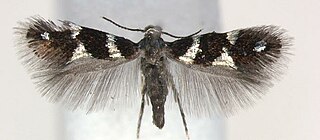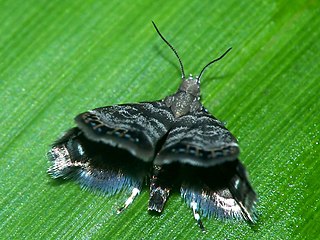
The Heliozelidae, commonly known as shield-bearer moths, are a family of small, day flying monotrysian moths distributed worldwide. The larvae of most heliozelid species are leaf miners who cut distinctive shield-shaped cases from the surface of the host leaf, hence the common name. Some species are considered pests of commercial crops such as grapevines, cranberries, and walnuts. The taxonomy of this family is poorly understood.
Metachanda is the sole genus in tribe Metachandini of moth subfamily Oecophorinae. Metachandini was originally described as family Metachandidae by Edward Meyrick in 1911, and at the time also contained the genus Chanystis, which is currently unplaced to tribe within Oecophorinae. It has also previously been described as tribe Metachandini of subfamily Gelechiinae.

Mnesarchaea is a genus of "New Zealand primitive moths" in the family Mnesarchaeidae. This genus is endemic to New Zealand.

Prays is a genus of moths of the family Praydidae, formerly assigned to Plutellidae or Yponomeutidae.

Xyloryctidae is a family of moths contained within the superfamily Gelechioidea described by Edward Meyrick in 1890. Most genera are found in the Indo-Australian region. While many of these moths are tiny, some members of the family grow to a wingspan of up to 66 mm, making them giants among the micromoths.

Brenthia catenata is a species of moth of the family Choreutidae. It was described by Edward Meyrick in 1907. It is found in India, Sri Lanka, the Philippines and Samoa.
Musotiminae is a subfamily of the lepidopteran family Crambidae. It was described by Edward Meyrick in 1884
Compsoctena is a genus of moths in the family Eriocottidae. It was erected by Philipp Christoph Zeller in 1852.
Compsoctena melitoplaca is a moth in the family Eriocottidae. It was described by Edward Meyrick in 1927. It is found in South Africa.
Compsoctena talarodes is a moth in the family Eriocottidae. It was described by Edward Meyrick in 1927. It is found in Tanzania and Zimbabwe.
Brachmia opaca is a moth in the family Gelechiidae. It was described by Edward Meyrick in 1927. It is found in China and Taiwan.
Dichomeris inclusa is a moth in the family Gelechiidae. It was described by Edward Meyrick in 1927. It is found in South Africa.
Dichomeris exsecta is a moth in the family Gelechiidae. It was described by Edward Meyrick in 1927. It is found in Zimbabwe.
Holaxyra acuta is a moth in the family Gelechiidae. It was described by Edward Meyrick in 1927. It is found in South Africa.
Eustalodes oenosema is a moth in the family Gelechiidae. It was described by Edward Meyrick in 1927. It is found on Samoa.
Hypatima trachymorpha is a moth in the family Gelechiidae. It was described by Edward Meyrick in 1927. It is found on Samoa.
Apatetrinae is a subfamily of moths in the family Gelechiidae. The subfamily was described by Edward Meyrick in 1947.
Moca chelacma is a moth in the family Immidae. It was described by Edward Meyrick in 1927. It is found on Samoa. Its type locality is Malololelei on the island of Upolu.

Gymnobathra is a genus of moths in the family Oecophoridae. It was first described by Edward Meyrick in 1883. All species are found in New Zealand.





